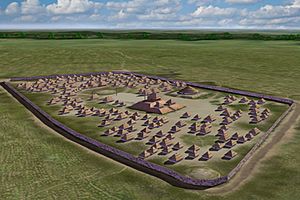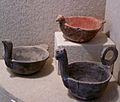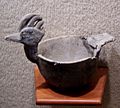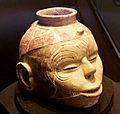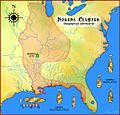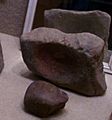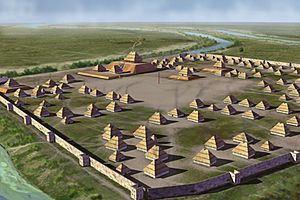Nodena phase facts for kids
The Nodena phase was a group of Native American villages that existed in eastern Arkansas and southeastern Missouri. These villages were part of the Late Mississippian culture. They lived there from about 1400 to 1650 CE. The Nodena people built their homes along the Mississippi River. They were skilled farmers, growing lots of maize (corn). They also shaped their babies' heads, a practice called artificial cranial deformation. The Nodena people were connected to a large trade and religious network across North America called the Southeastern Ceremonial Complex. Through this network, they got special materials like chert (a type of stone) and whelk shells.
The famous Spanish explorer Hernando de Soto and his team are thought to have visited some Nodena phase sites in the early 1540s. These sites are often believed to be the "Province of Pacaha" mentioned in de Soto's records.
Contents
Where Did the Nodena People Live?
Nodena phase villages were found in three main areas. These areas are near the towns of Wilson-Joiner, Wapanocca Lake, and Blytheville.
Wilson-Joiner Area Villages
- Nodena site - This is the most important site for the Nodena phase. It's located east of Wilson, Arkansas, right on a bend of the Mississippi River. A doctor named Dr. James K. Hampson first found and studied this site. You can see artifacts from the Nodena site at the Hampson Archeological Museum State Park in Wilson.
- Pecan Point site (3 Ms 78) - This site was explored by Clarence Bloomfield Moore around 1910 or 1911.
Wapanocca Lake Area Villages
The biggest village in the Wapanocca Lake area was the Bradley site (3 Ct 7). The Bradley Site and other nearby villages are good candidates for being the capital city of Pacaha. This is where the de Soto expedition might have visited.
Blytheville Area Villages
- Campbell Archeological Site (23 Pm 5) - This site is in southeastern Missouri. People lived here from 1350 to 1541 CE. It has a large mound, a village, and a burial ground. This site has given us the most Spanish artifacts found in southeastern Missouri. Things like glass beads, a bell, iron knife pieces, and part of a brass book cover were found here.
- Chickasawba Mound (3 M 55) - This mound is also known as the Blytheville Mound. It was added to the National Register of Historic Places in 1984.
- Eaker site (3 Ms 105) - This large village site is near Blytheville, Arkansas. It's one of the biggest and most complete Nodena phase villages. It also shows signs that the Quapaw people lived there later. Like many old settlements, it's next to a river, the Pemiscot Bayou.
Nodena Culture and Daily Life
Pottery Making
Most pottery found at Nodena sites is called Mississippian Bell Plain. It was a light brown color. It contained small pieces of ground mussel shells to make it stronger. Some pottery was very fine, with shells ground so small you could barely see them.
The Nodena people made many different shapes and designs. Some pots had bright, swirling patterns. Others were shaped like human heads, animals, or hunters. They made pottery by rolling clay into strips and then smoothing them together. They didn't use a potter's wheel. They painted their pottery using natural colors: white from galena, red from hematite, and black from graphite. A popular design was a red swastika on a white pot. Sometimes they carved designs into the clay, but this was rare. Women likely made the pottery. A woman's grave at the Nodena site had 11 polishing stones and a pottery anvil.
Tools and Stone Work
The Nodena people traded with other groups to get stone for their tools. They lived in a floodplain, so there was no stone nearby. They got chert, basalt, and sandstone from areas like Crowley's Ridge.
They made many tools, including celts (like axes), chisels, adzes, hoes, and arrowheads. A special arrowhead style is called the Nodena point. It's a delicate, leaf-shaped point. Nodena points have been found in many places across the American Midwest and South. There were two types: the Nodena Elliptical and the Nodena Banks. The Banks type has a straight base. Sandstone was also used to make round, polished stones called discoidals. These were used in a game called chunkey.
Farming and Food
The Nodena people were very good at farming. They grew a lot of maize (corn), as well as beans, squash, sunflowers, and gourds. They also gathered wild foods like pecans and persimmons.
When de Soto's team visited, they said the area was heavily farmed. They also saw many wild fruit and nut trees. This suggests the Nodena people left these trees when clearing land for corn. They also hunted animals like deer, squirrels, rabbits, and turkeys. They fished for alligator gar, catfish, and mussels.
Head Shaping
The Nodena people practiced artificial cranial deformation, also known as head flattening. When babies were very young, they were strapped to a special carrier. This gently shaped their skulls as they grew. Many skeletons found at the Nodena site had flattened foreheads and backs of their heads. Out of 123 skulls found by Dr. Hampson, only six looked "normal." This practice does not affect how the brain works. Many Native American tribes did this, including the Choctaw.
Burial Customs
The Nodena people had family cemeteries. They buried people lying on their backs, usually facing north or south. They also placed items with the deceased for the afterlife. Graves often included a bowl and a bottle near the head. These were usually fine, decorated pots. Sometimes tools were also buried, like the pottery-making tools found in a woman's grave.
Language Spoken
The Nodena people likely spoke either Tunican or Siouan languages. We know the Tunica people were in the area when de Soto arrived. Later, by the 1670s, the Dhegiha Siouan-speaking Quapaw people lived there. It's hard to connect the Nodena people directly to modern tribes using old records or pottery styles.
Nodena's Neighbors and Conflicts
Other groups living nearby at the same time included the Parkin phase, Tipton phase, Menard phase, Belle Meade phase, and Walls phase. These groups were often rivals or allies, and they fought wars with each other. The presence of palisades (strong fences), earth walls, and moats (ditches filled with water) around their towns suggests that fighting was common.
De Soto's records say that the Pacaha (Nodena people) had been at war for a long time with a group called the Casqui. The Casqui's main town is thought to be near Parkin, Arkansas, at the Parkin Archeological State Park. Differences in pottery and burial customs show that the two groups had been separate for a while. The records say the Pacaha and Casqui had fought for many generations. This long war led to a stalemate, where neither side could win. Attacks only happened when one side felt sure they would succeed. The Pacaha controlled more land and had more people than the Casqui.
Other groups mentioned in de Soto's records, like the Aquixo and Quizquiz, were likely under the control of the Pacaha.
What Happened After Europeans Arrived?
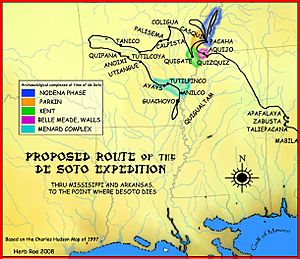
De Soto first met the Casqui tribe. When he went to visit the Pacaha, many Casqui people followed him. Many Pacaha people, seeing their enemies approach, fled to a fortified island in the river. Some drowned trying to escape. The Casqui who followed de Soto then attacked the Pacaha village. They damaged the temple, disrespected the remains of the honored dead, and stole everything they could.
De Soto talked to Chief Pacaha and convinced him that his expedition had nothing to do with the attack. He said they wanted peace. De Soto even offered to help the Pacaha attack the Casqui to punish them. The Casqui heard about this plan. They decided to return the stolen items and apologize to avoid being attacked by the combined Spanish and Pacaha forces. De Soto then arranged a dinner for the two chiefs and helped them make a peace treaty. As a thank you, Chief Pacaha gave de Soto one of his wives, one of his sisters, and another woman. De Soto's expedition stayed in Pacaha's village for about 40 days.
The records from the Hernando de Soto expedition are the only historical accounts of Chief Pacaha and his people. We don't know much about what happened to them later. By the time other Europeans, like Jacques Marquette and Louis Jolliet, explored the area in 1673, very few people lived there. It is believed that European diseases like smallpox and measles greatly reduced the population. The arrival of the Spanish also upset the balance of power among the local tribes. De Soto's team had described the area as the most populated they had seen in "La Florida."
Some people have tried to connect the Nodena people to modern tribes. Because they were in the area, the Quapaw were long considered a possibility. More recent studies have focused on the Tunica people, who lived in the Lower Yazoo River valley by the late 1600s.
Images for kids


